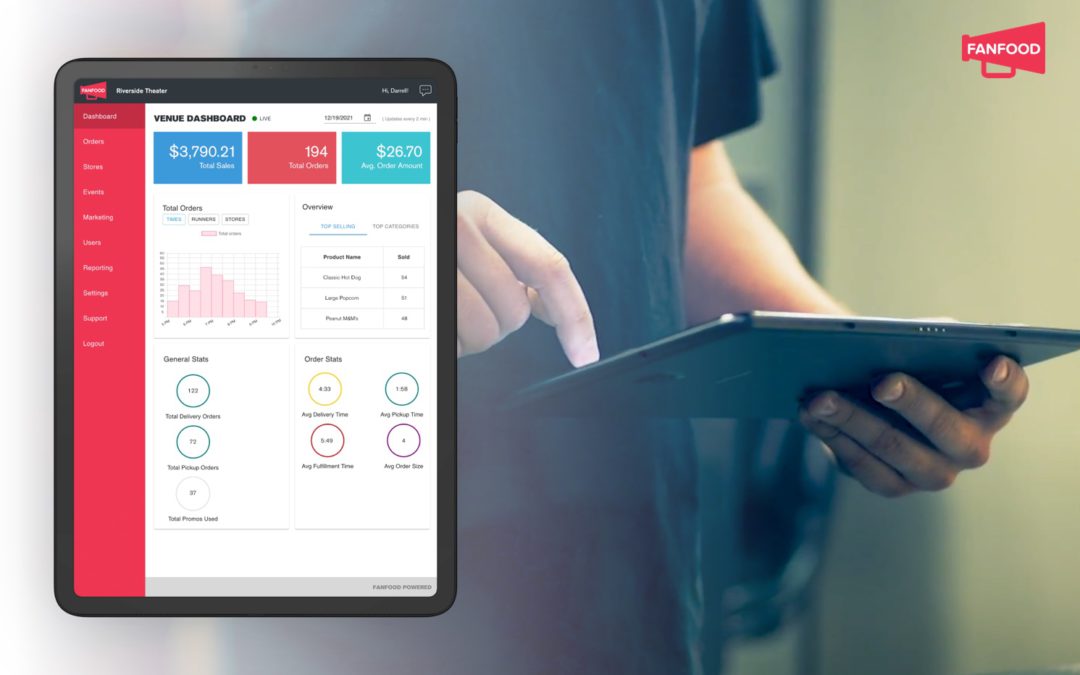Whatever the size of your concession stand or your daily traffic, you should always know your customers well in order to maximize the revenue potential. Over the last few years we’ve seen the foodservice industry getting increasingly data-centric, partly powered by the popularization of technology that has made tracking key metrics effortlessly easy. For example, if you’re using a mobile ordering platform like FanFood, you can capture important user behavior data that a cash register can’t.
In this blog, we’ll discuss the following:
- Why should you track key customer metrics
- Which metrics should you be tracking
- How to best track customer metrics
Why should concession stands track customer metrics?
Metrics are an effective way to give you a snapshot view of your customer behavior and sales performance. It’s the most standardized, straightforward and measurable way to gauge how healthy your sales and operations are, and help you optimize for higher profitability over time.
Set goals
First of all, metrics help you determine what you should set as your business goals, and give you a target to hit. For example, if your goal is to maximize profits, you might want to set goals around new customers acquired, repeat customers and average spend per customer. If you want to focus on improving the customer experience, then customer satisfaction rate and repeat rate would be good metrics to track.
Monitor progress
By tracking the right metrics regularly, you can have visibility into whether you’re on track to hitting your targets, and whether new initiatives you implement are working. If something isn’t working, you can quickly correct the course without wasting too much time or resources on going down the wrong path.
Surface problems
Abnormal numbers or consistent deterioration of certain metrics can alert you to potential problems in your operations. For example, if your repeat customers as a percentage of total customers consistently decrease, you might need to look into customer experience and satisfaction to see if there’s anything you can do to improve customer retention.
Which metrics should you be tracking?
1. Total customers per time period
Ideally you want to see a consistent increase in total number of customers on a weekly, monthly and annual basis. Depending on the nature of your business, the time period across which you want to compare the metrics could vary. If you run a concession stand at a sports venue, you want to compare total customers per game, per homestand or per season. If your concession stand is year-long with pretty consistent traffic, you can compare the total number of customers per week or per month, and observe the trend from there.
Generally speaking, the more customers you have, the higher your revenue is likely to be. Of course, there are many other factors that will affect revenue, which we will discuss later. But having a consistently high or growing customer base typically is an indicator that your business is healthy and doing well.
2. Number of customers as a percentage of total visitors
Most concession stands operate as part of a venue or location, such as a stadium concession stand or a park concession stand. If you can get the numbers, or at least a rough estimate, of how many people visit your venue, you can get a ratio of how many people out of those visitors actually purchase from your concession stand. If only a very small percentage of total visitors purchase from your stand, you might need to reconsider your menu offerings or pricing. If there are multiple concession stands and your competition is seeing a higher percentage of traffic, you might want to understand what it is that your competition is doing well that you aren’t.
3. Repeat customer rate
This metric measures what’s the percentage of repeat customers out of your total customers. If you have a high percentage of repeat customers — congratulations, you have a very loyal customer base and people love purchasing from you over and over. It’s also worth looking into what your repeat customers are purchasing each time. This might help you figure out the winning formula for your menu. However, depending on your concession stand’s location, sometimes you don’t get many repeat customers due to the nature of your industry. For example, if you run a high school concession stand, you’re likely to see many repeat customers since the same students and parents will come to most of the games. On the other hand, if you run a concession stand at a tourist attraction, you might not see many repeat customers since most visitors are people traveling from elsewhere.
In addition, it’s also worth noting that sometimes an overly high repeat customer rate might not be a good sign. It might also indicate that you aren’t doing enough to attract new customers. Therefore achieving a healthy balance is important.
4. Average order value (AOV)
AOV measures how much on average a customer spends per order. There are two ways to increase your AOV: either by raising your prices or getting people to purchase more items within one order.
One highly effective way to achieve both is creating combo menu items, which we elaborate in length in this blog. With combos, you can combine items from different categories, such as a main course + a snack + a drink to increase the number of items purchased within one order. You can also try slightly increasing the price of the overall combo package, since combos are typically perceived as a better deal. We also recommend that you give each new combo a fun, exciting name and description. A theater might want to give movie-themed names to their combos, whereas a stadium might want to give team-related names to their combos.
5. Average number of orders per customer
As much as possible, you want to incentivize people to place multiple orders during one visit. If you run a drive-in theater for instance, with two screenings per night, you want to get movie-goers to purchase a full meal before the first showing and maybe another snack between two showings. This way you can increase the average spend per customer and maximize the revenue from the customer base you have.
One way to do this is simplify your order-taking process, where people can place an order whenever and wherever they want on their phone. This is why every 1 in 3 drive-in theaters in the U.S. uses FanFood, which allows customers to scan a QR code and order directly on their phone without leaving the car.
6. Average spend per customer
This metric tells you how much on average a customer spends at your concession stand. If you can increase your metric #4, average order value and metric #5, average number of orders per customer, you’ll likely see an increase in average spend per customer.
By tracking this metric, you’ll understand how valuable each customer is. To go one step further, if you segment your customers by demographics, time of visit or other traits, you can start separating your most valuable customers from your less valuable customers, and focus on acquiring and retaining your highest revenue contributors. For example, a parent might have a higher average spend because he or she is purchasing for a family of 6, versus those who are just buying a drink or snack for themselves.
If your average spend per customer is low, think about ways to increase that number by offering upsells, such as adding a drink or snack upon checkout, or create combo items to encourage customers to spend more per order. If you’re interested, we have an entire blog on how to design your menu to incentivize higher spend.
How to best track customer metrics?
Choose the right tech platform
Instead of manually calculating these numbers in an Excel spreadsheet (which, let’s be honest, is tedious and as a result hard to stick to), we recommend using a digital order taking platform that not only makes the customer experience better, but also tracks key customer data for you.
For example, on FanFood you’ll have access to all of the above key metrics within your dashboard. You can track sales numbers in real time, and recap it over any period of time that you filter by. This has helped a lot of our venue partners understand their customers better, and adjust their operations accordingly.
Train your staff
Along with choosing the right platform, you’d also want to make sure that your staff know what metrics you’re tracking, especially those whose activities directly impact your operations. Ideally if relevant, you’d want to train your staff to monitor metrics in real time during opening hours, and adjust their operations accordingly.
Know the benchmarks
Benchmarks help you compare if you’re on track or off track when looking at your numbers. There are different ways to set benchmark numbers. One way is to look at the industry standard, or if you can, look at the metrics of your competitors. If those are not available, you can pull the data from the past few months or so, and compare your current performance over time. Ideally you’d always want to beat your previous numbers, unless you need to consider external factors such as seasonality.


Recent Comments